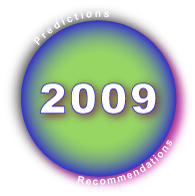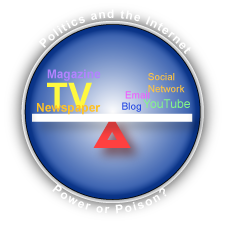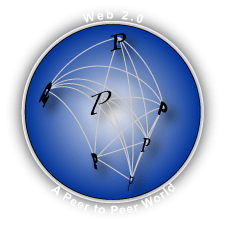By Christopher Rollyson  Learning how to leverage social networks for business will be one of the top five requirements to thriving in 2009, and LinkedIn is an ideal place to begin because it helps to find opportunity: new customers, partnerships or jobs. The Executive’s Guide to LinkedIn has scheduled three new Collaborative Seminars in Chicago and Cleveland. Here is how participants increase their results: Learning how to leverage social networks for business will be one of the top five requirements to thriving in 2009, and LinkedIn is an ideal place to begin because it helps to find opportunity: new customers, partnerships or jobs. The Executive’s Guide to LinkedIn has scheduled three new Collaborative Seminars in Chicago and Cleveland. Here is how participants increase their results:
- EGLI participants create their individualized LinkedIn plans
- They learn how to build their networks and manage their time according to the plan
- They learn how to use LinkedIn’s advanced tools
By Christopher Rollyson  Alumni 2.0 Employer-Employee Realignment explains that the biggest misalignment at many organizations is with their employees—and how to realign. Alumni 2.0 Employer-Employee Realignment explains that the biggest misalignment at many organizations is with their employees—and how to realign.
We have all heard about “Business-IT Alignment” ad nauseum through the 1990s and beyond (even today), but an even greater enterprise misalignment is fast approaching: human capital management. In the Knowledge Economy, large organizations and individuals are having to adjust to the changing employment paradigm which features increasing volatility and uncertainty. Enterprises need agility (read “the ability to fire and hire”) while employees need security (read “decent affordable healthcare and transition aid”). Each party will win when the transaction cost of finding new work situations falls. Therein lies the simple truth of the new realignment, and social networks should be put on the front lines.
By Christopher Rollyson Volatility, Uncertainly and Opportunity—Move Crisply while Competitors Are in Disarray
 Now that the Year in Review 2008 has summarized key trends, we are in excellent position for 2009 prognostications, so welcome to Part II. As all experienced executives know, risk and reward are inseparable twins, and periods of disruption elevate both, so you will have much more opportunity to produce uncommon value than normal. Now that the Year in Review 2008 has summarized key trends, we are in excellent position for 2009 prognostications, so welcome to Part II. As all experienced executives know, risk and reward are inseparable twins, and periods of disruption elevate both, so you will have much more opportunity to produce uncommon value than normal.
This is a high-stakes year in which we can expect surprises. Web 2.0 and social networks can help because they increase flexibility and adaptiveness. Alas, those who succeed will have to challenge conventional thinking considerably, which is not a trivial exercise in normal times. The volatility that many businesses face will make it more difficult because many of their clients and/or employees will be distracted. It will also make it easier because some of them will perceive that extensive change is afoot, and Web 2.0 will blend in with the cacaphony. Disruption produces unusual changes in markets, and the people that perceive the new patterns and react appropriately emerge as new leaders.
By Christopher Rollyson Editor’s Choice of the Global Human Capital Journal—Accelerating Disruption and Opportunity
 What a year! When I wrote in the 2007 Year in Review that 2008 “would produce an unimaginable degree of change,” I had no idea how right that would prove to be. We saw major disruption in the global economy, and the U.S. presidential campaign closed the year with a major political upset, largely at the hand of social media. That said, I still believe that 2008 will prove to be a transitional year and that more profound change is on the way. What a year! When I wrote in the 2007 Year in Review that 2008 “would produce an unimaginable degree of change,” I had no idea how right that would prove to be. We saw major disruption in the global economy, and the U.S. presidential campaign closed the year with a major political upset, largely at the hand of social media. That said, I still believe that 2008 will prove to be a transitional year and that more profound change is on the way.
Look in any direction. From a macroeconomic perspective, the global economy is showing itself to be pervasively interdependent. The U.S. successfully exported its real estate finance crisis without even working up a sweat. I don’t believe that anyone really knows where all the bodies are buried yet, and central bank chairmen, national presidents and global organization leaders are still holding their breaths, even though they smile bravely on television. Barack Obama’s successful U.S. presidential campaign showed that a new era of politics is upon us; as we’ll discuss below, it will likely redefine how “democracy” operates. A new phase of disintermediation is afoot.
Continue reading Year in Review—2008: Social Media Out of the Gate and in Full Run
By Christopher Rollyson Conventional Wisdom Scuttled—Disruption Preview—Business in the Batter’s Box
 Barack Obama’s presidential campaign was more than a major social media milestone because it ushered in a new relationship model among leaders and their supporters. Due to social media, an unprecedented number of individuals had a new kind of active, direct role in Obama’s campaign; moreover, I predict that the Obama campaign and imminent administration will change citizens’ and consumers’ expectations of “leader” and “follower” roles in government and business. Amazon.com changed consumers’ expectations about retail in general—information on demand, reviews, unbelievable variety at low prices—and a significant portion of Obama supporters will want to continue their support to “make the change happen.” These supporters will bring their changed expectations of action and collaboration to their vendors. That means your company. Barack Obama’s presidential campaign was more than a major social media milestone because it ushered in a new relationship model among leaders and their supporters. Due to social media, an unprecedented number of individuals had a new kind of active, direct role in Obama’s campaign; moreover, I predict that the Obama campaign and imminent administration will change citizens’ and consumers’ expectations of “leader” and “follower” roles in government and business. Amazon.com changed consumers’ expectations about retail in general—information on demand, reviews, unbelievable variety at low prices—and a significant portion of Obama supporters will want to continue their support to “make the change happen.” These supporters will bring their changed expectations of action and collaboration to their vendors. That means your company.
The Obama campaign is very instructive to business leaders because business customers are changing expectations of their leaders, as we’ll discuss in more detail below. As the Global Human Capital Journal is not primarily focused on politics, I am less interested in the fact that Obama was elected than how he was elected. Moreover, I’ll go on record now as predicting that you will experience Obama’s use of social media increasingly in 2009, and I believe that the election will prove to be only the beginning: the Obama Administration will leverage social media in governing. Although Global Human Capital endorsed Obama, I have no inside knowledge of the campaign or its strategies. Obviously, this is a huge subject, so I will use this post primarily as a way to frame an ongoing discussion so that it may prove valuable to business and government executives.
Continue reading Web 2.0 Case Study: Barack Obama’s Use of Social Media
By Christopher Rollyson I’ll be speaking at the Social Networking Conference in Miami, January 23, 2009, about a subject that I predict will be in the headlines in 2009-2012: social networks will become a key part of the solution for reforming U.S. healthcare. Although everyone has agreed for years that the U.S. healthcare system has needed an overhaul, people have not agreed on what has had to be done, when or how, and this has created an obstreperous impasse. Social networks offer an intriguing possibililty to help reform the system because they can enable emergent organization and cross-boundary collaboration. They can start small and plug numerous communication and collaboration gaps in healthcare workstreams. In Miami, I will offer eight case studies to show how people are already collaborating to change key elements of the system.
By Christopher Rollyson Strategy for LinkedIn, Facebook, Twitter: Where Do I Need to Be? shows how to take an ecosystem approach to social networking platforms, so you can use each one for what it does best and create more leverage.
This morning I was interviewed by Canright Communications, a corporate marketing firm, about LinkedIn’s value proposition for executives, and Collin retweeted the “where do I need to be” question, so I’ll offer a thumbnail guide to figuring that out here. Although the chief context remains leaders of companies and agencies, you should find the thoughts broadly applicable to your situation. I also invite inquiries using the comment functionality beneath this post.
Continue reading Strategy for LinkedIn, Facebook, Twitter: Where Do I Need to Be?
By Christopher Rollyson 2009 Poised as Inflection Point in Enterprise Usage—LinkedIn Increases Relevance to B2B Executives
 During the 1990s, I was intimately involved with helping global organizations to decentralize their information technology—as a management consultant and marketing executive. However, a far more disruptive force is imminent today: communications and marketing are rapidly evolving into a networked, distributed pattern, following IT’s lead. Individuals that congregate online will have an increasing role in affecting how other people make decisions, significantly weakening the influence of the mass media on which many marketing strategies depend. Organizations that depend on centralized, controlled communications will be astonished at how fast they become irrelevant over the next five years. Although the case studies are still being written, I’ll go on record as saying that the 2008 U.S. presidential election will prove to be an inflection point of digital social networks’ disruptive potential. During the 1990s, I was intimately involved with helping global organizations to decentralize their information technology—as a management consultant and marketing executive. However, a far more disruptive force is imminent today: communications and marketing are rapidly evolving into a networked, distributed pattern, following IT’s lead. Individuals that congregate online will have an increasing role in affecting how other people make decisions, significantly weakening the influence of the mass media on which many marketing strategies depend. Organizations that depend on centralized, controlled communications will be astonished at how fast they become irrelevant over the next five years. Although the case studies are still being written, I’ll go on record as saying that the 2008 U.S. presidential election will prove to be an inflection point of digital social networks’ disruptive potential.
LinkedIn is a leading venue for B2B and B2C executives, so it merits significant attention. The inputs for this Executive Adoption Snapshot are varied: I have had the opportunity to work with hundreds of executives to apply LinkedIn to their business processes in 2008. I met two LinkedIn executives this month, and I covered CEO Dan Nye’s recent interview. I will synthesize clients’ experiences and LinkedIn executives’ remarks in three sections: 1) Executive Summary, 2) remarks from Dan Nye, Patrick Crane and Steve Patrizi, and 3) Analysis and Conclusions.
I would also be remiss if I did not share some of my experience around what kind of services enterprises will require to excel in this new environment, so after Analysis and Conclusions, I have provided initial thoughts gleaned from my experiences with clients thus far working with Web 2.0.
By Christopher Rollyson  Think about this a minute: most executives began their careers before Web 1.0, the rise of the Internet. We remember going to the library to do research, phone canvassing to find an expert or a store, even going to the post office. Now the speed of business is drastically faster because we can find all kinds of information on demand, and we can transact close to instantly. Think about this a minute: most executives began their careers before Web 1.0, the rise of the Internet. We remember going to the library to do research, phone canvassing to find an expert or a store, even going to the post office. Now the speed of business is drastically faster because we can find all kinds of information on demand, and we can transact close to instantly.
Imagine that things are poised to shift again—only much more radically. Professional (social) networks enable us to find knowledge and people on demand and, if we know how to conduct ourselves, those people will want to help us do very important things. LinkedIn is emerging as the premier professional (social) network: due to the law of network effects, it will become more influential the larger the portion of the executive market it captures. The San Francisco Chronicle just published an excellent interview with LinkedIn CEO Dan Nye to which I’ll contribute my insights here.
By Christopher Rollyson  Although I’m far from impartial, I believe that Q3 has seen the most innovation yet, which is one of the reasons I’m writing this deep into Q4! I am launching and growing the Executive’s Guide to LinkedIn by leveraging social networking to the hilt. Here I’ll review some of the highlights of how I’m doing it. Although I’m far from impartial, I believe that Q3 has seen the most innovation yet, which is one of the reasons I’m writing this deep into Q4! I am launching and growing the Executive’s Guide to LinkedIn by leveraging social networking to the hilt. Here I’ll review some of the highlights of how I’m doing it.
The main insight and driving strategy is difficult to write about: I have made social networking the DNA of this business. Social networking logic now drives much of the strategy. Before you yawn (obviously there are many companies doing this), remember that we are using social networking with executives (Boomers, older Xers). This is not in their DNA, so using social networking is not all that obvious.
Continue reading 2008 Q3 Report
|
|
 Learning how to leverage social networks for business will be one of the top five requirements to thriving in 2009, and LinkedIn is an ideal place to begin because it helps to find opportunity: new customers, partnerships or jobs. The Executive’s Guide to LinkedIn has scheduled three new Collaborative Seminars in Chicago and Cleveland. Here is how participants increase their results:
Learning how to leverage social networks for business will be one of the top five requirements to thriving in 2009, and LinkedIn is an ideal place to begin because it helps to find opportunity: new customers, partnerships or jobs. The Executive’s Guide to LinkedIn has scheduled three new Collaborative Seminars in Chicago and Cleveland. Here is how participants increase their results:






